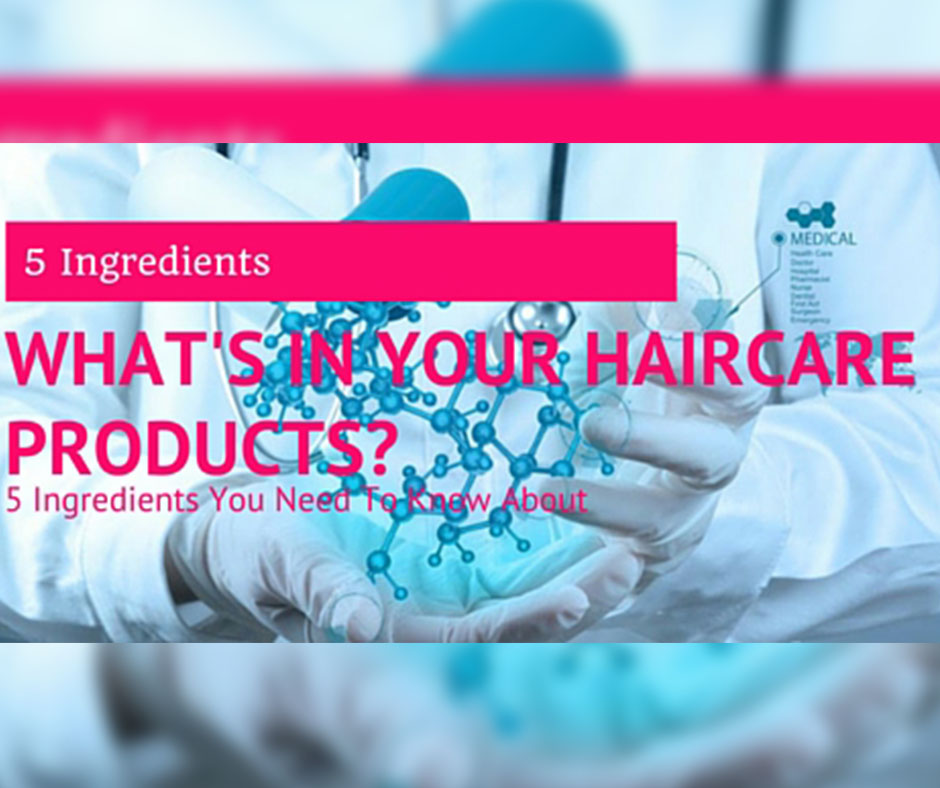What’s in your haircare products?
It is always best to know what is used for ingredients to your haircare products, not just for the simple case of you might be using harmful chemicals on yourself, but you may also develop problems for your hair and scalp in the long term; putting yourself in danger if unaware of the risks.
How can haircare products be harmful?
Hairstyling products have the purpose of changing the shape, texture, or to hold a style in place. Although most styling products won’t cause damage; for those containing alcohol, it can dissolve the important oils in your hair, and consequently it will decrease your hair quality.
Also, if there is a toxic build-up then this will cause dull hair, a change in your hair texture and also lead to an itchy scalp or dandruff.
What’s in your haircare products?
Sulfates
By having a quick glimpse at the ingredients that is shown on the haircare product; you should be able to tell if sulfates have been included or not. You want to look out for sodium laureth sulfate (SLES) or sodium lauryl sulfate (SLS); these are commonly found in shampoos, toothpaste, and soaps.
It is a highly popular ingredient for its foaming properties, its ability to make your hair feel refreshed, and it is cheap to obtain in a mass manufacturing level.
Why are sulfates harmful to your hair?
There are a number of reasons why sulfate is bad to have in your haircare products:
- Sulfates can cause irritation to your hair, skin and eyes; the strength of the side effect can be different from one person to the other, so any symptoms that does occur should immediately be shown to your doctor.
- It can also remove all your essential hair oils, which not only dries it out, but can lessen the overall quality of your hair. Your hairs appearance and feel can be affected.
- Long term use of sulfates, especially in shampoos, can cause long term damage to your hair in terms of both health and appearance.
- In less common occurrences, sulfate can also cause swelling to your hands, arms and face.
If you are using sulfate in your haircare products, then you can look into options of instead buying sulfate free shampoos and products.
What is SLES?
It is a detergent and surfactant that is most commonly found in haircare products. Unlike its similarity to SLS, this agent doesn’t have an ethoxylation step. It is the detergent that is most likely to cause eye irritation.
What is SLS?
SLS is a compound that is extracted from coconut or palm oil, which is then mixed in with other chemicals. It can be an agent that can put you at risk from skin irritation; those who suffer from eczematous dermatitis should especially keep away from any haircare products containing SLS.
What is ALS?
Ammonium Lauryl Sulfate has very high foaming properties to the user, however not only can it cause skin problems, but it has also been linked with respiratory problems too.
What else is in your haircare products that can be harmful?
Parabens
What are parabens?
This agent can also be identified as methylparaben, butylparaben or propylparaben; they all contain strong antifungal and antibacterial properties, which act as preservatives and is able to extend the shelf life for the products they are used in.
How are parabens harmful?
Paraben has been known to cause the following symptoms:
- Rosacea
- Dermatitis
- Allergic reactions, especially for those who are prone to skin sensitivity.
- In worst case scenarios, paraben has been found to damage hormones in men and women.
Can Parabens get into your body?
Through research, Paraben has also been found inside tissue samples, and higher concentrations of it were found in breast tumor tissue. It has become more evident that Paraben is able to enter your body by absorption from the skin – and even more alarmingly they have been found intact which means the agent is able to bypass the liver! In amounts greater than 25%, it has been proven that Parabens can have adverse affects on your body.
What are Phthalates?
These are usually labelled on the ingredients as Phthalate esters or simply fragrance. This chemical is primarily used for helping products to retain their scents for longer periods.
Very similar to Parabens, this ingredient can create problems for human hormones, especially if you are exposed to high levels of it.
What are the harmful side-effects to Phthalates?
Apart from allergic skin reactions, and a disruption to your hormones; Phthalates have also been linked to causing breast cancer, type II diabetes, neurodevelopmental issues, autism, behavioral issues, spectrum disorders, problems with reproduction, hyperactivity disorder, asthma, and having a low IQ.
What types of Phthalates are there?
There is a huge range of Phthalates available, but the most problematic are Benzyl Butyl phthalate, BBP; Di-n-octyl phthalate, DNOP; Di-2-ethylhexyl phthalate, DEHP; Di-butyl phthalate, DBP; Dipentyl phthalate, DPP; Diisononyl phthalate, DINP and Butyl benzyl phthalate, BBZP.
What can you do about the harmful chemicals in your haircare products?
In the majority of cases, you should look into switching your regular products to alternatives that don’t offer the harmful chemicals. The internet is always a great source for not only research on what’s new on the market, but you can also access loads of online retailers that sell completely natural and chemical free products.
What if there is no other option with a product I can use for haircare?
It is understandable that with the more advanced haircare products, it’s not viable to switch over to a product that is completely free from chemicals; you will then want to look at how much you use, and if you are able to cut down in usage.
Chances are that if you use a chemical product infrequently, then it will not do you any significant harm; as the small portion of the chemical won’t be enough to affect your body.
If you are using them chemicals frequently; you should definitely either seek a new hair regime of cutting down its use, or to see whether it is viable to switch for another chemical-free alternative.
What should I do if I notice any symptoms from using haircare products?
You should immediately see your doctor and show your symptoms; you may need to explain about all the haircare products you are using, in order to find the agent that is responsible. Your doctor will need to assess to see if it is an allergic reaction, or the possibility of being something more severe.
To prevent this from happening, then you should always read the label and always know what’s in your haircare products.








